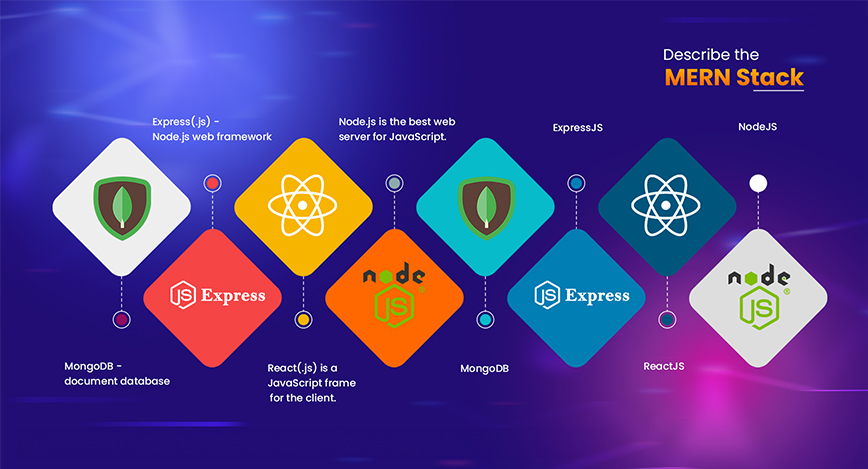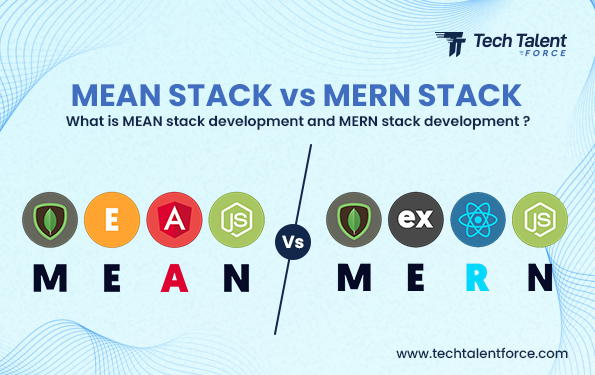Introduction:
Your decision about choosing the technology stack can significantly impact the success of your project. With plenty of options available, it is vital to understand the advantages and disadvantages of each stack. It helps you decide which one is a better option for you.
Two of the most popular full-stack JavaScript frameworks are MEAN and MERN stacks. Both offer tools to build dynamic and scalable web applications. In this comparison article, we will understand the difference between them. Plus, we will also discuss how they work and what are their pros and cons.
What is MEAN stack?
The MEAN stack is a JavaScript-based framework used to build scalable web apps. It has four major elements – MongoDB, Express.js, Angular, and Node.js. All of these parts use the same programming language, JavaScript.
What are the components of the MEAN stack development?
- MongoDB: This is used to store information about your website or app.
- Express.js: Express.js helps to build the backend of your website or app.
- Angular: Angular is a powerful client-side framework for building dynamic web applications.
- Node.js: This runs the JavaScript code on your computer instead of in a web browser.
How does MEAN stack work?

MEAN stack integrates the above four components and builds full-stack web applications. Let us see how it works:
- Data storage: MongoDB serves as the database for storing application data. Unlike traditional databases, it uses a flexible document-based structure. It makes it adaptable to various data types.
- Server-side logic: Express.js handles the backend operations of the application. It manages incoming requests, routes them to appropriate functions, and interacts with the database to fetch or store data.
- Front-end development: Angular, the front-end framework in MEAN, constructs the user interface. It displays data fetched from the server, allows user interactions, and updates the display accordingly.
- Runtime environment: Node.js offers the platform to run the entire application. It implements the JavaScript code on the server and the client side.
MEAN stack - Pros and cons
Pros
- MEAN stack uses JavaScript for both client and server-side development. This ensures code consistency.
- It simplifies the entire development process.
- Components like Node.js and MongoDB handle growing and dynamic applications.
- Angular’s features enhance dynamic and responsive user interfaces.
- MongoDB’s format aligns well with JavaScript and makes data handling smooth.
Cons
- It may seem hard to use in the beginning because Angular.
- Angular's full-fledged nature may overwhelm smaller projects.
- MongoDB's flexibility may lead to less structured data models.
When to use MEAN stack ?
MEAN is best for:
- Websites which have a lot of content.
- Apps that need to handle a large user base.
- Projects that need to be completed quickly.
What is MERN stack?

MERN is very similar to MEAN, but it uses React instead of Angular to create the part people see.
Components of MERN stack development
How does the MERN stack work?
- Data storage: Data storage: Exactly like the MEAN stack, here in the MERN stack also, MongoDB is used to store application data. Exactly like the MEAN stack, here in the MERN stack also, MongoDB is used to store application data.
- Server-side logic: Server-side logic: This is also the same here. Express.js handles server-side operations. Plus, it also manages incoming requests, routes them to appropriate functions, and interacts with the MongoDB database. This is also the same here. Express.js handles server-side operations. Plus, it also manages incoming requests, routes them to appropriate functions, and interacts with the MongoDB database.
- Front-end development: Front-end development: React develops the user interface and updates the UI based on data changes from the server. React develops the user interface and updates the UI based on data changes from the server.
- Runtime environment: Runtime environment: The runtime environment is also the same here in the MERN stack. Node.js offers the platform to run the entire application and implements JavaScript code. The runtime environment is also the same here in the MERN stack. Node.js offers the platform to run the entire application and implements JavaScript code.
Pros and cons MERN Stack
Pros
- React.js, the distinguishing part of MERN, helps build dynamic and responsive user interfaces.
- MERN's components (especially Node.js and MongoDB) are designed to handle growing and evolving applications.
- Each MERN component has a vibrant ecosystem of libraries, tools, and community support.
Cons
- Developers new to MERN can find it hard to learn when starting. Especially for full-stack development.
- Achieving real-time updates may require additional technologies or libraries.
When to use MEAN stack ?
MERN is great for:
- Websites and apps that need to change often.
- Projects that need to be finished quickly.
- People who prefer a simpler way to build the UI of their website or app.
|
Feature
|
MEAN Stack
|
MERN Stack
|
|---|---|---|
|
Database
|
MongoDB
|
MongoDB
|
|
Server-side framework
|
Express.js
|
Express.js
|
|
Client-side framework
|
Angular
|
React
|
|
Runtime environment
|
Node.js
|
Node.js
|
|
Data interchange format
|
JSON
|
JSON
|
|
Architectural pattern
|
Model-View-Controller (MVC)
|
Component-based
|
|
Complexity
|
Higher learning curve
|
Generally lower learning curve
|
|
Project scope
|
Large-scale enterprise applications
|
Broad range of applications, including smaller projects
|
|
Community support
|
Strong and established
|
Extensive and active
|
|
Performance
|
Solid performance
|
Often optimized for performance
|
|
Flexibility
|
More structured approach
|
Greater flexibility and adaptability
|
|
Search Engine Optimization (SEO)
|
Requires server-side rendering (SSR)
|
Requires server-side rendering (SSR) for optimal results
|
|
State Management
|
Built-in state management solutions (NgRx)
|
Typically requires external libraries (Redux, Context API)
|
Conclusion
In conclusion, MEAN and MERN both offer certain advantages. The MEAN stack offers a robust framework with Angular, making it suitable for complex, large-scale applications, while the MERN stack’s use of React provides flexibility and is ideal for dynamic user interfaces. However, to choose between these two, it is required to consider your specific project requirements and team expertise. This way, you can choose a suitable stack as per your preferences.
Both are full-stack developers, but the difference lies in their expertise. MEAN stack developers specialize in Angular and MERN stack developers are experts in React.
MEAN is a suitable option for you if you want to build large-scale enterprise applications. On the other hand, MERN is widely used for building dynamic user interfaces.
MERN is a complete full-stack development stack and it offers the required tools to build web apps from databases to the user interface.
MEAN stack is used for developing a diverse type of web apps like social media platforms, e-commerce websites, real-time applications, and enterprise-level software.
The MEAN stack uses angular in the front-end structure while the MERN stack uses React JS for the user interface.




No Comments